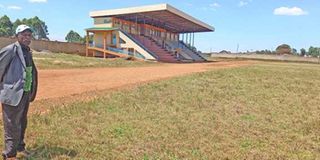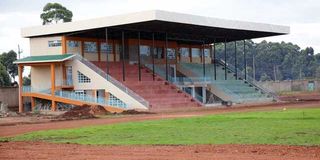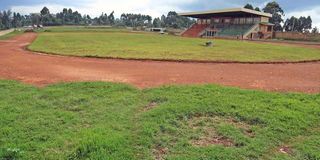Work on Manga Stadium in Nyamira County falls nine years behind schedule

Legendary runner Charles Asati who was a member of Kenya men’s 4x400m relay team that won gold at the 1972 Olympics in Munich surveys Manga Stadium in Nyamira County on March 15. Asati trained for the 1972 Olympics at the stadium.
What you need to know:
- Nyamira County Executive for Sports Grace Nyamongo said she was not in a position to issue a timeline for completion of the project.
- Governor Amos Nyaribo, who has been at pains to explain why the stadium project stalled, did not answer our calls.
Manga Stadium in Nyamira County has a storied history.
It is where Charles Asati, a member of Kenya’s 4x400 metres men’s team that won gold at the 1972 Olympic Games, trained prior to the quadrennial games.
At the time, Manga Stadium was no more than an open grassy field stretching over four acres of land. Spurred on by ambitions of winning a medal at the Olympics, Asati and other athletes trained on the field, keen to avoid the fringes which were overgrown by grass. Unknown to them, the grounds would remain in the same state for the next 42 years.
When Nyamira County government launched an ambitious plan in 2014 to upgrade the grounds by building stadium at the grounds to international standards, it inspired optimism among locals, including Asati who had long retired. It promised to give to give rise to the next generation of stars.

The main pavilion of Manga Stadium in Nyamira County on December 22,2021.
Manga Stadium would be constructed to international standards, the county government announced.
Nine years later, the project has not moved beyond the first phase. A site visit by Nation Sport this week established that construction work had stopped and the contractor had left the site.
With the region currently experiencing heavy rains, a pool of stagnant water on the running track is the first thing that greets a visitor to the site.
An estimated Sh109 million has been pumped into the project since 2014 and there is nothing much to show for it.

The surface of Manga Stadium in Nyamira County on April 20, 2022.
Ex-Governor John Nyagarama, who has since passed on, presided over the ground-breaking ceremony in 2014, and the stadium was to be constructed in four phases over four years.
The first phase was to involve construction of a perimeter wall and a drainage system, levelling of the playing surface and drilling of boreholes. This was to take a year to complete.
The second phase of the project was estimated to take one and half years would involve construction of the main pavilion with a capacity for 3,000 VIPs, installation of an irrigation system on the playing surface, and levelling of the running track.
The third phase involving construction of six spectator stands and areas for indoor games was to take another year.
Another year was to be spent on the fourth and final phase of the project which involved installation of an artificial running track and security lights at the stadium.
The project fell behind schedule, and the county government issued new time lines which were also missed.
The first contractor constructed a perimeter wall round the stadium in 2016 and left the site in unclear circumstances, leaving the project in limbo for three years. Another one was hired in 2019.
The tender for construction of the main pavilion, running track and installation of irrigation and drainage systems on the playing surface and planting of grass on the pitch was awarded to Kisii-based contractor Saumo Enterprise Limited Company.
A murram running track has been made and the playing surface levelled. A pavilion that is estimated to accommodate 3,000 people is complete.
A spot check by Nation Sport further established that pipes for drainage and underground irrigation have been installed, and the contractor has left the site.
The contractor, Angelica Maturu of Saumo Enterprise Limited Company, told Nation Sport that late payment by the county government is delaying the project.
It has been three months since the second contractor left the site after the county government declined to allocate funding for the project.
“The county government added more work that was not in the initial plan. I cannot work without money,” she said.
There are claims that the topography of the parcel of land does not favour construction of a stadium.
Initially, the football pitch was planned to measure 51 metres by 90 metres, something Football Kenya Federation.
The federation directed the contractor to extend the pitch to cover an area of 51m by 100m.
Last week, Asati, one of the Kenya’s pioneer sprinters who represented the country at the 1968 (Seoul, Mexico) and 1972 (Munich) Olympic Games and who trained for the games at Manga Stadium, was a bitter man.
Asati was a member of Kenya’s 4x400m relay team that won gold in 1972 in Munich Olympic Games. His team mates were Hezekiah Nyamao, Robert Ouko and Julius Sang.
Asati singled out the stalled Manga Stadium, a venue where he trained as an athlete, as a major let down for the county which is endowed with great sporting talent.
“It is sad that there is no stadium that can host major events in this region. The delay is hurting young talents who want to emulate other great sportsmen and women globally,” said Asati.
Nyamira County may not produce star athletes like Asati and Ouko soon because it’s not clear on when the project will be completed.
Nyamira County Football Kenya Federation (FKF) chairman Luthers Mokua said the region is rich in sporting talent but lacked training facilities.
“County officials must come out and tell the public how much they have spent on that project” he said.
The county lacks a standard stadium that can host major events. All sporting events in the region are normally referred to the neighbouring Kisii County.
The region is not represented in FKF Premier League, National Super League, women's league and FKF division one league.Local clubs from the county only compete in grass roots competitions.
Once complete, Manga Stadium is expected to have a main stand and the VIP area with a seating capacity for 4,000 people, and other six spectator stands. The whole facility will accommodate about 10,000 people.
However, the fate of the project hangs in the balance as the county government has failed to issue a definite timeline on when work will resume.
Asked on the timelines, Nyamira County Secretary Jack Magara referred the matter to the department of sports.
Nyamira County Executive for Sports Grace Nyamongo said she was not in a position to issue a timeline for completion of the project.
Governor Amos Nyaribo, who has been at pains to explain why the stadium project stalled, did not answer our calls.
Tomorrow: Sudi Stadium offers hope for development of sporting talent in Bungoma County





